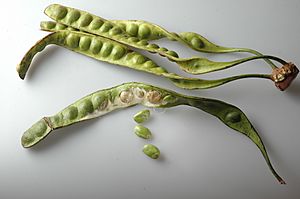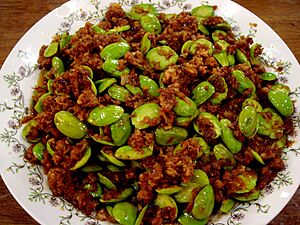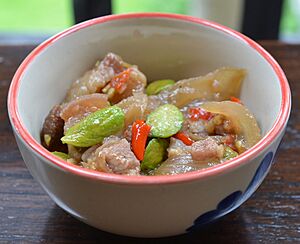Bitter bean facts for kids
Quick facts for kids Bitter bean |
|
|---|---|
 |
|
| Seed pods | |
| Conservation status | |
| Scientific classification | |
| Genus: |
Parkia
|
| Species: |
speciosa
|
| Synonyms | |
|
|

Parkia speciosa, often called the stink bean, bitter bean, or twisted cluster bean, is a fascinating plant. It belongs to the Parkia family, which is part of the larger Fabaceae (pea and bean) family. This plant grows long, flat, edible pods. Inside these pods are bright green seeds that look like plump almonds. They have a unique, strong smell, a bit like shiitake mushrooms. This smell comes from special sulfur compounds found in the beans.
Contents
What is the Stink Bean Plant Like?
The stink bean tree can grow very tall, up to about 30 meters (almost 100 feet). Its flowers grow in a shape like a light bulb at the end of long stems. These flowers make a sweet liquid called nectar. This nectar attracts bats and other animals that help the plant make seeds.
The fruits of the stink bean plant grow as long, twisted, and somewhat see-through pods. They usually hang in a group of seven or eight pods. When these pods are fully grown, they hold the special stink beans or seeds inside them.
How People Use Stink Beans in Cooking
The beans from Parkia speciosa and other Parkia plants are very popular in cooking. You can find them in countries like Indonesia, Malaysia, Singapore, Brunei, Laos, southern Thailand, Burma, and parts of northeastern India.
These beans are often sold in bunches, still inside their pods. Sometimes, the seeds are taken out and sold in plastic bags. People collect the pods from wild trees or from special farms. They are also exported in jars or cans, often pickled in salty water, or sold frozen.
The stink bean is known as petai or pete in Indonesia, Malaysia, and Singapore. In some places, it might be called yongchak or Jonglha. These beans taste best when cooked with other strong-flavored foods. Good examples include garlic, chili peppers, dried shrimp, or shrimp paste. A popular dish is sambal petai, which is a spicy sauce with stink beans.
When the pods are young, they are flat because the seeds have not grown yet. They look like slightly twisted, pale green ribbons. At this early stage, you can eat them raw, fried, or pickled. Young, soft pods with small beans can even be used whole in stir-fried dishes.
The seeds can also be dried for later use. When dried, they turn black. Stink beans look a lot like broad beans. Just like mature broad beans, you might need to peel them before cooking. The stink bean got its nickname because its strong smell can stay in your mouth and body for a while!
Stink Beans in Indonesian Food
In Indonesia, petai is very popular, especially in the highlands of Java and Sumatra. Many people, like the Sundanese and Minangkabau, enjoy it. In Sundanese cuisine, petai is sometimes eaten raw with sambal as part of lalab (a fresh vegetable salad). It can also be fried or grilled. Sometimes, it is stir-fried and mixed with oncom (a fermented food).
In Java and Sumatra, petai might be added to sayur lodeh (a vegetable curry) or sambal goreng ati petai. This last dish is fried diced beef or chicken liver cooked in sambal with petai. A very popular dish is nasi goreng kambing petai. This is a type of fried rice made with goat meat and petai. In Padang cuisine, petai is often part of lado (a spicy sauce) for ayam pop (a fried chicken dish).
Stink Beans in Indian Food
In Manipur, a region in India, the stink bean is called yongchak. It grows mostly in the hilly areas and some other parts of the Manipur valley. The yongchak found here is a bit harder than the ones from Thailand or Malaysia. The wild type from the hills is usually sold in markets. Some types of Parkia are grown by farmers in northeast India. In other parts of India, it is grown as a decorative plant or a shade tree. This bean has also become an important part of many foods in Tripura.
In Manipur, the seeds or whole beans are used to make local dishes. These include Hmarcha dêng, Eromba (a traditional Manipuri chutney), or Yongchak singju (a traditional Manipuri salad). Eromba is a common dish made with boiled potato, fermented fish, chili, and other vegetables, including Parkia. Yongchak singju is another favorite side dish. It is made by cutting Parkia into small pieces and mixing them with a hot chili paste. Parkia is also used in many other dishes with fish and vegetables.
The Kuki people in North-East India call it "Jonglha". The Rongmei Naga Tribe calls it Kampai. They cook it with meat or make it into a salad. Sometimes, the seeds are eaten with a chutney made from dried fish. The Hmar people call it Zawngṭa and often prepare it with chili, baking soda, a little salt, and a special fermented pork called "Saum".
In Mizoram, the Mizo people also love the stink bean, calling it Zawngṭah. They eat the whole bean after removing the outer skin, and they also eat the seeds. It is eaten raw as a side dish or used in chutney recipes. They also prepare it with chili and fermented pork called Saum. This is a very common side dish among many groups in the region.
Stink Beans in Malaysian and Singaporean Food
In Malaysia and Singapore, petai is often served with sambal. It can also be mixed with dried shrimp, chili peppers, red onions, belacan (prawn paste), soy sauce, and prawns. Another popular side dish for nasi lemak (a fragrant rice dish) or plain rice is petai beans cooked with fried dry anchovies and a stir-fried chili sambal (called sambal tumis).
Stink Beans in Thai Food
In Thailand, the stink bean is called sah-taw (Thai: สะตอ). A well-known dish is mu phat sah-taw, which is stir-fried pork with stink beans.
See also
 In Spanish: Petai o sataw para niños
In Spanish: Petai o sataw para niños




